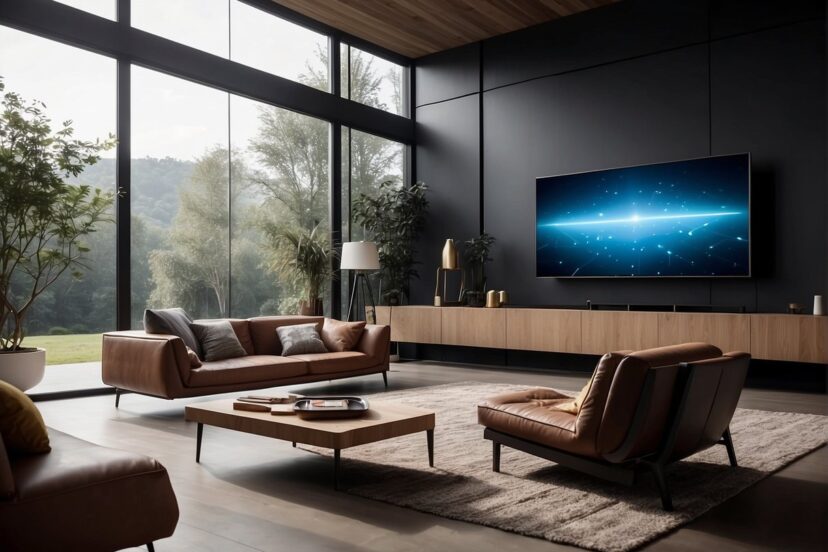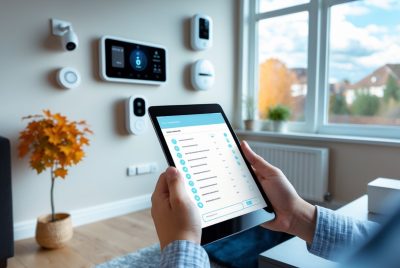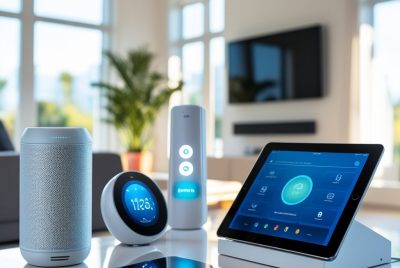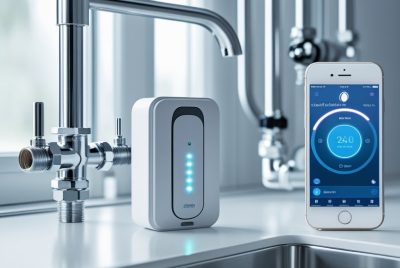Smart Home Ideas: Enhancing Your Living Space
*We may earn a commission for purchases made using our links. Please see our disclosure to learn more.
Smart Home Ideas: Enhancing Your Living Space with Technology
Looking for Smart Home Ideas to revolutionize your home? In recent years, I’ve seen a surge in the popularity and capability of smart home devices, transforming ordinary households into cutting-edge, automated environments. The advancement in technology has brought a plethora of devices to market, ready to cater to every aspect of domestic life. From security to convenience, energy efficiency to entertainment, smart home devices offer homeowners the ability to tailor their living spaces to their unique needs and preferences.

I understand that navigating the smart home landscape can be overwhelming, with hundreds of products vying for attention across numerous categories. However, the underlying goal of these devices remains the same: to create a home that’s more convenient, secure, and responsive to its inhabitants. Whether it’s through voice-activated assistants or remotely controlled appliances, the modern home is rapidly becoming a place where digital intelligence meets physical space.
With expert insights and rigorous testing, it’s possible to discern which smart home technologies are worthwhile investments. The best smart home devices are not only the ones that offer flashy features but also those that provide practical solutions, seamlessly integrating into daily routines. In 2024, this integration is smoother than ever, with devices designed to work together and create an ecosystem that’s both intuitive and powerful.
The Foundation of Smart Home Technology

In this section, I will explain the fundamental concepts behind smart home technology and guide you through the essential elements that form the core of any intelligent home system.
Understanding Smart Home Basics
Smart homes leverage advanced technology to provide convenience, energy efficiency, and security. At its core, smart home technology integrates various devices and appliances, enabling them to communicate with each other and be controlled remotely. Through home automation, these smart devices are often connected via Wi-Fi, which allows for seamless operation and monitoring from anywhere with internet access.
- Voice Commands: Control devices using spoken instructions.
- Sensors: Detect changes in the environment such as motion or temperature.
- Energy Consumption: Monitor and manage the energy use of connected devices.
Key Components of a Smart Home
Several critical components are crucial for the establishment of a smart home:
- Central Hub or Controller: My personal command center for smart devices, allowing centralized control.
- Networking Devices: Includes routers and extenders to maintain strong Wi-Fi coverage for all my devices.
- Smart Devices: Ranging from smart bulbs to smart locks, these devices are the building blocks of my smart home.
| Device Type | Utility in Smart Home |
| Smart Bulbs | Lighting control and energy savings |
| Smart Locks | Enhanced security and access control |
| Smart Thermostats | Efficient heating and cooling |
| Smart Appliances | Intuitive operation and monitoring |
By integrating these devices, I can create a cohesive and responsive smart home ecosystem that adapts to my preferences and lifestyle, making my home safer, more comfortable, and energy-efficient.
Smart Home Control and Connectivity

In the domain of smart homes, the seamless control and connectivity of various devices are paramount. I find that the integration through voice assistants, smart ecosystems, and wireless protocols are key to a sophisticated and functional smart environment.
Voice Assistants and Smart Speakers
Amazon Alexa and Google Assistant lead the pack when it comes to voice-controlled smart assistants. I can operate numerous smart devices with simple voice commands to either the Echo or Echo Studio for Alexa, or Google Home devices for Google Assistant. Apple’s Siri also plays a significant role in voice-controlled environments, working through the HomePod as well as other Apple devices to manage tasks within the Apple HomeKit framework.
- Amazon Alexa: Supports a broad range of smart home devices.
- Google Assistant: Recognized for its advanced conversational experiences and integration.
- Siri: Known for its integration within the Apple ecosystem, prioritizing user privacy.
Smart Home Ecosystems and Integration
When I select a smart home ecosystem, I consider compatibility and efficiency. Apple HomeKit is a secure platform designed to support a variety of compatible devices seamlessly, using Siri for voice control. Google Home not only responds to voice commands via Google Assistant but integrates with devices for a cohesive system. On the other hand, Samsung’s SmartThings is a versatile ecosystem supporting multiple protocols and standards, such as Matter, to ensure cross-brand interoperability.
- Apple HomeKit: Facilitates a tightly integrated array of compatible devices.
- Google Home: Offers a broad-based integration platform for diverse smart home products.
- Samsung SmartThings: Known for its flexibility and compatibility with a wide range of standards.
Wireless Protocols and Standards
I’ve recognized that the backbone of smart home connectivity relies on various wireless standards. Wi-Fi and Bluetooth are common, but there are also specialized protocols like Zigbee and Z-Wave, which offer low-power networking options. The recent advent of Matter, a new industry-unifying standard, holds promise for the future by ensuring devices from different brands are compatible with each other.
- Wi-Fi: Used for high-bandwidth devices, such as cameras and streaming devices.
- Zigbee/Z-Wave: Suitable for low-power devices requiring long battery life.
- Matter: Aims to simplify development for manufacturers and increase compatibility for consumers.
Enhancing Home Security

To fortify a home against potential intrusions and breaches, integrating smart security technology is imperative. My focus here is on two critical facets: smart locks and surveillance systems.
Smart Locks and Access Control
Smart locks are a cornerstone of home security, offering both convenience and enhanced control over access to the property. I recommend looking into brands like August or Schlage for retrofitting existing deadbolts or installing new, keyless entries. These smart locks often integrate with systems such as SmartThings or SimpliSafe, enabling remote control and monitoring through a smartphone.
- Features to consider in smart locks:
- Remote access via mobile apps
- Integration with smart home ecosystems
- Guest access with revocable digital keys
- Auto-locking and unlocking based on proximity
Surveillance and Security Cameras
A consistent visual on one’s home perimeter exponentially increases security. Companies like Arlo, Ring, and SimpliSafe offer robust security cameras and smart doorbells equipped with motion sensors that relay real-time alerts and footage to homeowners. Smart video doorbells not only capture video but often include two-way audio, allowing one to communicate with visitors or deter potential threats.
- Key attributes of effective surveillance systems:
- High-resolution video capture (1080p or higher)
- Night vision capabilities
- Motion detection with customized zones
- Integration with smart home hubs and systems (e.g., SmartThings, Ring)
By leveraging these sophisticated devices, I reinforce not just the physical safety of a home but also provide peace of mind, a fundamental aspect of any security plan.
Intelligent Climate and Lighting Solutions

For homeowners seeking to enhance comfort and convenience while potentially reducing energy costs, intelligent climate and lighting solutions are pivotal areas to focus on. With advancements in smart technology, I now have the ability to fine-tune my living environment for both efficiency and ambiance through the use of smart thermostats and lighting systems.
Smart Thermostats and Climate Control
Smart thermostats offer a level of automation and control previously unseen in home climate management. Devices such as the Ecobee smart thermostat not only allow for remote adjustments but also learn my daily patterns and adjust the temperature accordingly.
- Remote access: I can adjust my home’s temperature from anywhere using my smartphone.
- Learning capabilities: Over time, the thermostat understands my preferences.
- Energy reports: Some models provide detailed energy usage reports, which help me track and manage my heating and cooling expenses.
By integrating smart thermostats into my home system, both the convenience and potential cost savings are significant.
Smart Home Ideas: Smart Lighting and Bulbs
Switching to smart lighting is not just about convenience; it’s about transforming the way I illuminate my home. With smart light bulbs like Philips Hue, I get a spectrum of colors and the ability to control them via voice or mobile app. Key features include:
- Automation: Set the lights to gradually brighten in the morning as a wake-up call or dim at sunset.
- Voice control: I can simply tell my smart system to turn on or off a lamp, change colors, or adjust brightness.
- Flexibility: I can configure scenes for different occasions or times of the day.
Overall, intelligent climate and lighting solutions offer a blend of luxury and practicality that I find indispensable for modern living. With devices that learn from my patterns and respond to my preferences, my home not only becomes more responsive but also more attuned to my personal lifestyle.
Smart Entertainment and Convenience

I find that the core of smart entertainment and convenience in a modern smart home revolves around the integration of smart TVs and streaming devices, as well as the utilization of robotic cleaners and smart appliances. These advancements have significantly elevated the ease of managing and enjoying the home environment.
Smart TVs and Streaming Devices for Smart Home Ideas
Smart TVs are at the heart of any smart entertainment setup. For instance, models from Samsung and LG have integrated streaming capabilities, which allow me to access a wide range of on-demand content without the need for additional hardware. To further augment the experience, streaming devices, such as the Amazon Fire Stick or Roku, turn any regular TV into a smart TV, offering a variety of streaming services.
The integration with smart speakers like the Amazon Echo allows me to control my viewing experience with voice commands. Whether I want to play a movie, pause a TV show, or even search for content, I can do so without lifting a finger.
- Popular Streaming Services:
- Netflix
- Hulu
- Disney+
- Amazon Prime Video
Smart Home Ideas: Robotic Cleaners and Smart Appliances
My home cleaning has been revolutionized by robotic cleaners like the Roomba. Not only do these devices ensure that my floors are always clean, but they can also be scheduled to clean at the most convenient times for me, and many even self-charge.
When it comes to the kitchen, smart appliances have made cooking and food storage more intuitive and efficient. A smart oven can preheat on my way home, and a smart refrigerator can keep track of groceries and suggest recipes. Smart appliances often provide alerts and updates on my smartphone, which help me keep tabs on the status of my laundry, the contents of my fridge, or even when the oven has preheated.
- Examples of Smart Appliances:
- Robot Vacuums: Roomba
- Smart Ovens: Preheat settings, recipe suggestions
- Smart Refrigerators: Inventory tracking, expiration alerts
Additionally, a smart garage door opener brings convenience for not just me but also for family members or guests who might need access when I’m not home. With all these devices in place, my home not only entertains but also supports a convenient and modern lifestyle.
Frequently Asked Questions about Smart Home Ideas
In this section, I’ll address some common inquiries about smart home technology, helping you make informed decisions about upgrading and integrating devices for a more connected and efficient home.
1. What are some top smart home devices every homeowner should consider?
I recommend starting with smart speakers like Google Home or Amazon Echo, smart thermostats such as Nest or Ecobee, and smart lighting solutions from Philips Hue or LIFX. These devices provide a solid foundation for convenience and energy efficiency.
2. How can I integrate smart home technology into my existing home without major renovations?
Smart plugs and wireless control systems are ideal for adding smart functionality without the need for complex installations. I suggest looking for devices that can simply plug into existing outlets and connect to a Wi-Fi network for immediate use.
3. What are the benefits of setting up a home automation system?
The primary advantages include increased energy efficiency, enhanced security, and greater convenience. Home automation allows for the remote control and scheduling of devices, which can lead to significant cost savings and peace of mind.
4. Which smart home ecosystem is considered the best for seamless device integration?
Google Assistant and Amazon Alexa ecosystems are known for their broad compatibility and ease of use. Selecting devices within the same ecosystem can minimize issues and streamline the control process.
5. What innovative smart gadgets are available for enhancing kitchen and home functionality?
Look into smart refrigerators that track groceries, smart ovens that can be controlled remotely, and automated vacuum cleaners like the Roomba. These gadgets can transform daily tasks into more manageable and efficient experiences.




